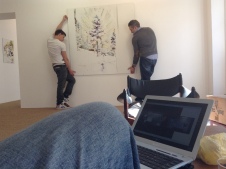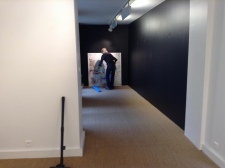Convenors: Professor Elizabeth Edwards (IAS 2012), Professor Jonathan Long (Durham)
Conference Panel forming part of the Durham Institute of Advanced Study conference on Transfusion and Transformation: the Creative Potential of Interdisciplinary Knowledge Exchange, July 15th – 17th 2014
The panel takes place 4pm – 5.30pm on Thursday 15th July in the Kingsley Barrett Theatre of Durham University’s Calman Building.
The concept and metaphor of ‘translation’, as an approach to practices and effects, has become increasingly widespread across a range of disciplines: archaeology, history, anthropology, cultural studies and, of course, the field of translation studies itself, in a symbiotic flow of key concepts. T
This panel will bring together a group of interdisciplinary scholars to consider the act and object of photography as an form of cultural translation that moves a set of experiences – the war zone, the ritual event, the everyday – from one space of understanding to another.
The panel asks for whom, and under what circumstances can photographs be seen as acts of translation? How does this intersect with our understanding of ‘representation’? To what extent is photography assumed to be a universal language? To what extent is photography, as an act of translation, assumed, that is at the same time, to transcend that translation in the global flow of representations/ images? To what extent does photography claim or challenge universal categories of comprehension? Does it assume unproblematic and mutually exchangeable accessibility? What is its cultural shaping in the act of apprehension? How is the act of translation disrupted by moments of incomprehension?
Contributors will be asked specifically to bring recent thinking in translation theory to new thinking on photographic analysis to explore synergies and problems. Is ‘cultural translation’ an exhausted metaphor that assumes the universality of photographic meaning, or does it open a space in which the analysis of the cultural work of photographs can be enriched and refigured by thinking through the act of translation itself?
It is significant how many ‘trans-‘ words cluster around attempts to understand the social and cultural efficacy of photography – not only translation itself but transaction, transcription, transfiguration, transubstantiation, even transgression. Linguistic models have had a profound influence on photographic analysis in the past few decades. Translation promises to enrich photography studies because it adds a dynamic, diachronic, and dialogic dimension to our understanding of photography and the multiple acts of interpretation to which it perforce gives rise.
Papers
Jennifer Tucker (Wesleyan/York)
“Law and image as translation: photographs and maps go to court”
Legal evidence depends on the tension between transparency and translation, which may be defined as the process of translating words or text from one language into another, the conversion of something from one form or medium into another, or the process of moving something from one place to another. Photography’s introduction into the courtroom during the middle years of the nineteenth century transformed the practice of law: how lawyers constructed and argued their cases, presented evidence to juries, and communicated with each other. How were photographs used and perceived in the courtroom and in wider culture, and how did they affect judicial decision making and public perceptions of justice? This paper explores how, when, and why legal practice moved from a largely words-only environment to one more dependent on and driven by images, and how rapidly developing technologies have further accelerated this change. Building on recent work in legal and historical scholarship and translation studies, I show examples from a wide range of actual trials and 19th and 20th century evidence manuals to illustrate and explore the idea of photography as a ‘universal language’ or an ‘immediacy,’ but one that is itself an act of translation.
Elizabeth Edwards (de Montfort)
“The same everywhere? Photographic ethnographies and the challenge to universal translation.”
This paper will address the destabilising potential of ethnographic studies of photography on classic, linguistically-based theories of photographic universality. It will argue that the qualities of direct translation and comprehensibility which have been widely debated in western photography, and which have been at the base of critiques of global image flows, from The Family of Man exhibition to the internet, are complicated by the different social demands and expectations brought to photographs. Drawing on recent work from Australia, India, Solomon Islands and Papua New Guinea, the paper will argue that resistance to the idea of photography as universal translation has been grounded in the politics of representation and western hegemonies, but have largely excluded other ‘reclaimings of the real’ through which photographs are made to speak ‘different dialects’.
Janet Stewart (Durham)
“Photography, Petroleum Museums and the Sociology of Translation”
As Elizabeth Edwards (2013) has recently pointed out, despite the considerable body of critical literature that has been produced over recent decades in both photography theory and museology, the question of the role that photography plays in museums has only seldom been subjected to extended analysis. Notable contributions to this field include Gaby Porter’s (1989) essay on ‘The Economy of Truth’ and Edwards’s Raw Histories (2001), as well as recent contributions to Museum & Society (Stylianou-Lambert and Bounia 2012; Edwards and Mead 2013). This paper seeks to intervene in on-going debate about the use of photographs in museums by exploring the efficacy of employing the concept of ‘translation’ to shed light on the complex lives of photographs in these institutions. While Stylianou-Lambert and Bounia focus on photography in war museums, and Edwards and Mead turn their attention to the place of photographs in museum displays that engage with the colonial past, this paper focuses on the way in which photographs appear in museum displays that seek to narrate aspects of Europe’s oil history (another form of contested heritage). Focusing on the recently renovated oil and gas display in Aberdeen’s Maritime Museum, but drawing upon material from other European petroleum museums, this paper will attend to the multiple ways in which photography is employed in these institutions, analysing not only the displays but also marketing literature and other ephemera. The theoretical framework through which these photographic works – understood as both images and as objects – will be approached will draw upon the ‘sociology of translation’, developed by Bruno Latour and Michel Serres. Their focus on the relational nature of translation seems apposite when seeking to think through the particular example of the Petroleum Museum, an institution designed to mediate between technology and culture.
Jonathan Long (Durham)
“Translation in/of Photomontage”
In 1924, German designer and photomonteur John Heartfield produced a photomontage entitled 20 Years After: Fathers and Sons (Zwanzig Jahre danach: Väter und Söhne). The image uses a variety of motivic repetition known as translation or translational symmetry. This involves the serial repetition of a motif along a horizontal or vertical axis: moving a motif from one place to another. While easy to effect in simple abstract patterns, it is only practically possible with complex figurative subjects by means of photography. Translation, in this sense, is a quasi-universal operation, a form of visual organisation that can be found in cultural artefacts produced in most if not all societies. However, photomontage as form of political propaganda requires highly specific kinds of translation if it is to be effective. If it is so polysemous that it is incapable of translation into more or less determinate propositional content, it fails as propaganda. So this paper will map the universal translational capacities of photography onto the specific forms of translation demanded by the photomontage in order to develop an understanding of the operations and limitations of translation as both a photographic process and an explanatory schema.










Recent Comments